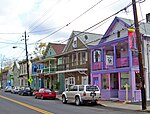Rosendale is a hamlet located in the Town of Rosendale in Ulster County, New York, United States. The population was 1,285 at the 2020 census. It was also a census-designated place known as Rosendale Village until 2010, when the U.S. Census Bureau designated it Rosendale Hamlet. Some maps continue to list the place as just Rosendale. As of 2020, the "Hamlet" in the CDP name was dropped.The area was originally settled in the late 17th century by Jacob Rutsen, a merchant from Albany, but did not become a major population center until the 1825 discovery of Rosendale cement in the region; the development of the cement industry, and the growth of the Delaware and Hudson Canal along the Rondout Creek and Main Street, gave rise to substantial economic development in Rosendale. The town's cement was used in the construction of numerous national landmarks. The Wallkill Valley Railroad reached the village in 1871, and its depot in the village was the largest station on the Wallkill Valley line. Rosendale was formally incorporated as a village in 1890.
An 1895 fire destroyed half the village, as it had no form of fire protection at that time. Throughout the 20th century, the decline of the natural cement industry caused Rosendale to suffer economically and lose population. The village was also battered by a series of severe floods, and the center of commerce began to shift from Main Street to Route 32. By the 1970s the village was having severe problems with its utilities and tax code, and was no longer producing cement. The hippie movement brought many artists to the village during this time, which led to ideological clashes between the newcomers and the more conservative, established residents. In 1976, the village voted to dissolve itself to solve its municipal problems, and on January 1, 1978, Rosendale became disincorporated. The village's mayor at the time of the vote viewed the dissolution as a work of conceptual art, and published a book on the matter.
After the disincorporation, the commercial center of the former village was revitalized by artists and entrepreneurs, who purchased and restored Main Street buildings that had fallen into disrepair. Since the 1990s, Rosendale has hosted many street festivals. The former village has had a number of notable buildings, including four churches. Two notable bridges span the Rondout Creek in the village: a road bridge that carries Route 32, and the Rosendale trestle, a former railroad bridge that was renovated as a pedestrian walkway. Joppenbergh Mountain, named after Rosendale's founder, borders the village and has been the site of numerous ski jumping competitions and mine collapses.










